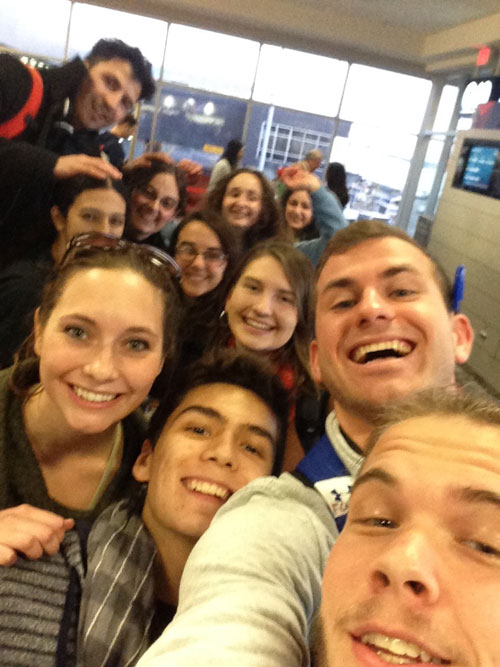Climate Talks: Dispatches from Paris
Contact
Environmental StudiesOlin-Rice Science Center, Room 249 651-696-6274
esson@macalester.edu
instagram twitter
Prof. Roopali Phadke’s “Climate Talks: Dispatches from Paris” class attended the 21st Session of the Conference of the Parties to the United Nations Framework Convention on Climate Change (COP21/CMP11) in Paris from November 30 to December 4, 2015.
- Opinion article by Harrison Beck ’16 – Star Tribune, December 14, 2015
- Opinion article by Ellen Andersen (U of MN), Laura Humes ’16 and Kayla Walsh ’16 – MinnPost, December 10, 2015
- Mac Students at COP21 – MacWeekly, December 4, 2015
- Opinion article by Laura Humes ’16 and Kayla Walsh ’16 – MacWeekly, December 4, 2015
- Minnesota Public Radio Interview – December 2, 2015
Daily Blog:
Friday, December 4, 2015
Day 5: Friday, December 4 by Harrison Beck and Mitch Paquette
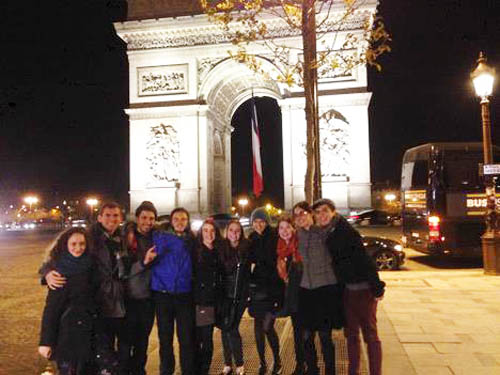
So what is COP21 like, REALLY!? One executive director of an international environmental NGO called it a “charade,” and stated that he is never so cynical as when he is at a COP. Another famous European scholar compared it to Disneyland. Our initial impression, at least of the Green Zone, the area of the conference open to the public, was that it is more akin to a playground, or a fictional bubble that bears much resemblance to the geography of power in the real world.
However, the same European professor who critiqued COPs in general also reflected that the Paris conference is the most hopeful of these international negotiations that he has attended. The bright lights, vibrant colors, and Crayola atmosphere, which has disillusioned some, may also be creating a positive mis-en-scene with short queues, good food, and cheery employees.
This, he said, relative to the dismal, chilly, bad-tasting environment of the Copenhagen accord in 2009, is establishing a more cooperative, happy-go lucky attitude amongst the negotiators that he thinks may lead to a successful agreement in Paris. What irked us about COP, having only our presumptions to compare it to, gave him optimism in light of the six previous COPs he had attended.
One expectation that we had coming into the conference was that in light of the recent Paris attacks and current national state of emergency, the presence of security would be overwhelming and would stifle the urgency. Rather, we found that the cops at COP21 kept their imposition to a minimum and did not play such a prominent role in the negotiations (though they would break up even small gatherings that weren’t planned). However, during our week there, they did tear-gassed an environmental protest in Paris, placed important activists on house arrest, and severely limited the presence of social movements at the conference, only amplifying the Crayola vibe.
Attending COP 21 was an enlightening experience for us rosy-eyed environmentalists. Students were able to attend panel discussions on climate migration, interview leading agro-economists, and participate in the breaking a day-long fast with interfaith communities from across the globe. Plus, we all shared a stellar bonding experience in the French city of love. For example, on their first full day in Paris, Harrison and Mitch explored the expansive, art-filled halls the famous Louvre. As we wandered endlessly through the museum, we likened the experience to something between a tour of Versailles and being lost in a corn-maze. Amongst the aged paintings such as the Mona Lisa (pictured below) and Napoleon’s apartment, we encountered no less than 5 sleeping museum-goers, exhausted from perhaps weeks of witless wandering with no end in sight.
On our final night in Paris, we spent it on the Seine on a nighttime boat cruise of the City of Lights. For our final meal, we had two courses of crêpes, both sweet and savory (they are crêpes-tastic!).
As we write these final reflections and remarks from 38,004 feet in the sky, we would like to give much thanks to our mighty leaders, Suzanne and Roopali, who made it all possible. Without their tireless efforts and months of planning, we would never have made such good memories and even better friends.
We love and appreciate you all — Forest, Akilah, Laura, Isabella, Kayla,
Jessica, Mariah, Chris, Suzanne, and Roopali—and won’t ever forget our week at the UN. It was a tremendous ride!
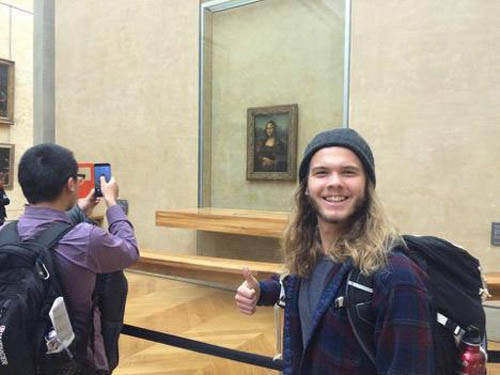
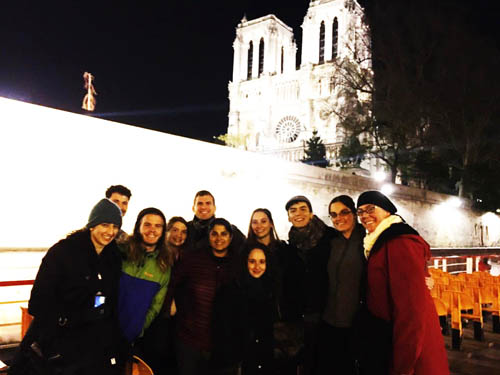
Thursday, December 3, 2015
Day 4: Thursday, December 3 by Jessica Timerman and Isabella Soparkar
Having had several days to explore the Climate Generations area, students used today to attend panels relevant to their research and conduct both formal and informal interviews with experts. Jessica interviewed Zaheer Fakir, a member of the board of the Green Climate Fund (GCF) and discussed the role of the GCF in agriculture and sustainable development. Jessica also spoke with Ben Lilliston from the Institute of Agriculture and Trade Policy based in Minneapolis and attended a panel of UNDP Equator Prize winners. The Equator Prize recognizes innovative community initiatives that build resiliency through inclusivity and systems thinking.
Similarly, Mitch interviewed the Ethiopian director of REDD+ (Reducing Emissions from Deforestation and Forest Degradation) about program’s functions in Africa; Kayla spoke with members of the Youth Delegation of SustainUS about the role of the media in influencing citizen perceptions of climate change issues; and Isabella asked the Minister of Foreign Affairs for the Republic of the Marshall Islands about his country’s contingency plans for climate displacement due to sea level rise. He stated that he hopes the world will move to mitigate climate change soon enough to avoid adaptation through migration, but acknowledged that good leaders must have contingency plans, and the people of the Marshall Islands could emigrate to the US if necessary. Isabella also had an impromptu lunch with the director of New York City’s Office of Recovery and Resiliency. In addition to sharing his insights into the partisan nature of current climate politics and his details on New York City’s new sustainability plans, he commented on the different experiences in the Blue Zone versus Green Zone or civil society space, saying, “I may not have accreditation [into the Blue Zone], but I have French Fries.”
Isabella and Kayla also attended a panel focused on a Strategic Plan on Oceans and Climate, post-COP21. During the questions period, a woman in the panel stood up and passionately accused the group of speakers of being trapped in an ivory tower and ignoring relevant issues. This felt like a manifestation of the frustration that many people in civil society feel about the gap between policy makers, civil society and scientists. The panel responded by telling the woman that this was not the place to voice her concerns, which was a reminder that all voices are not perceived as equal, even in the UN-sponsored civil society space.
In addition to their interviews and panels today, students witnessed “die-ins” where youth fell to the ground and pretended to be dead, making a statement about the potential impacts of climate change if a strong agreement does not result from COP21.
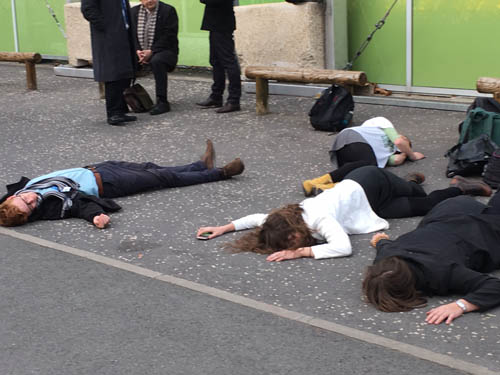
Outside of Climate Generations, Akilah attended a youth event at the science museum. She was able to connect with environmental justice advocates from the Midwest, as well as the former Vice Chair of the International Panel on Climate Change (IPCC). Mariah, Laura, and Chris continued attending events within the Blue Zone. They participated in a youth dialogue with Facebook’s Sustainability leaders about mobilizing with social media. A highlight from the Blue Zone was a panel featuring mayors from Oakland and Copenhagen.
In the evening, Forest and Jessica attended an Ecumenical Service at Notre Dame organized by the Council of Christian Churches in France. The service included a procession of many Christian faith leaders and performances by a children’s choir. They attended the service with members from the United Methodist Creation Care Team including representatives from Liberia, Argentina, Cambodia, Switzerland, and Minnesota.
In the evening, Macalester alum Alain Cardon treated the class to dinner at the elegant La Regalade, a restaurant located near the Louvre. He shared stories about Macalester protests in the late 1960s, recalled the construction of Weyerhaeuser Chapel, and told us that he was allowed to graduate from Macalester with 3 minors and no major!
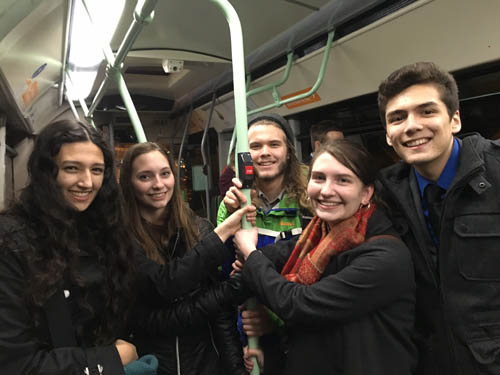
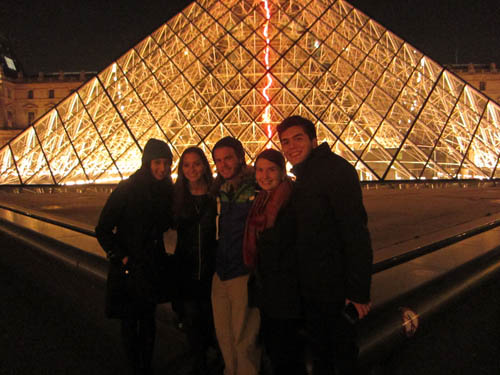
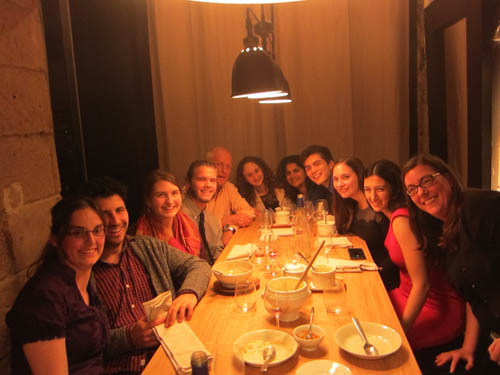
Everyone visited the Ice Watch exhibit at night at the Place du Pantheon in the Latin quarter. The display consists of 12 pieces of the Greenland ice sheet shipped to Paris in refrigerated containers. The ice blocks are positioned in a circle like a clock in front of the Pantheon, symbolizing the idea of time melting away. We saw a film crew take footage of a modern dance performance within the circle of ice. The ice melting provides a reminder of the imminent threat of sea level that progresses every day.
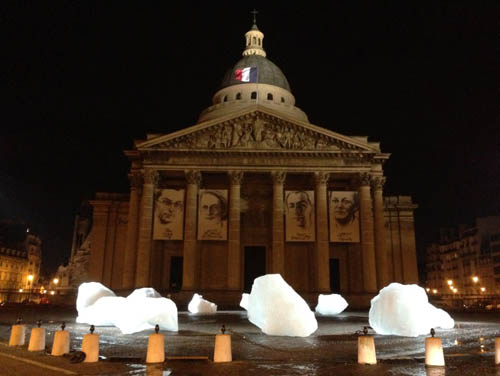
After a long but productive week, we are looking forward to our last day, but also sad to leave COP 21 after just beginning to figure how it all works.
Wednesday, December 2, 2015
Day 3: Wednesday, December 2 by Forest Redlin and Laura Humes
By being present in Paris during these historic negotiations, we have witnessed government, nongovernmental, civil society, and citizen actors converging to negotiate the future of the planet and its people. Over the course of the past few days, we have gained insight into what it truly means to “negotiate,” coming to understand the multiplicity of the term and the multitude of spaces in which negotiation in its many forms occurs. Negotiating our shared future first involves coming together to cultivate empathy. One event in Paris where this occurred was at the breaking of the fast event on Tuesday.
On December 1, 2015, thousands of people across the world took part in the Fast for the Climate. With many others here at COP21 and across Paris, Forest participated in this fast in solidarity with those most impacted by climate change. After a long day spent at the COP21 negotiations, over 100 civil society members and delegates alike came together at small church in Paris to break the fast with a celebratory feast in recognition of the hopeful aspirations for COP21.
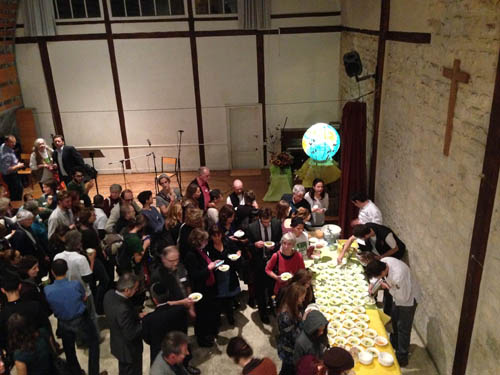
The Fast for the Climate campaign was inspired by Yeb Saño, delegate to the Philippines at the 2013 COP19 negotiations in Warsaw. Hours before the opening statements made by country delegates, the Philippines was devastated by Typhoon Haiyan. In his riveting opening statement, Yeb Saño vowed to fast for the remainder of the COP19 in solidarity with his friends, family, and fellow countrymen who were directly impacted by climate change.
Since that day in 2013, the Fast for the Climate has gained momentum. In 2014, the campaign called upon all people to fast on the first of every month. In 2015, on the road to COP21, the campaign organized a rolling fast assigning a new faster for every day of the year. Over this period of time, Yeb Saño sustained his leadership on climate change. In addition to representing Fast for the Climate as a COP21 delegate, Yeb and many others participated in the People’s Climate Pilgrimage – walking over 900 miles from Rome to Paris.
On the day of the fast, Forest spoke to fasters and asked the following question: Why do you fast? While many shared powerful and compelling stories, perhaps most interesting where subsequent discussions that delved into how different individuals approached the fast itself. For some, fasting was a way for them to feel the hunger those most impacted by climate change feel every day. Others embarked on their fast as a spiritual journey often times linked to various faith perspectives that consider fasting a time of prayer and closeness to God. And there were some that simply used the fast as a form of action to raise awareness for the necessity to address climate change.
Whether you identified with only one, none, or perhaps all of these interpretations of the fast, the underlying theme of these actions was one of collaboration and coalition building. The fasters expressed a deep sense of empathy – the ability to see and to feel the world through another’s perspective and use this connection to co-create positive solutions to address climate change.
We cannot help but recall a statement made by Macalester’s President Rosenberg in his recent interview with WCCO-TV: “If you were to look at our world right now and say what’s the problem, it’s hard to boil it down to one thing but I think you could make a pretty good case that an absence of empathy is at least one of the big problems we face.” In the case of climate change these words ring true.
While this analysis focuses on the Fast for the Climate, this movement is analogous to the approach necessary to catalyze the negotiations to promote a successful agreement. The Fast for the Climate has set a precedent for our world leaders. Will they follow?
In other news, students outside the conference attended the Tara Schooner Pavilion situated on the banks of the Seine. This venue includes both tours of the Tara (a ship built and operated by a French non-profit for high-level scientific research missions) and a conference room that is focused on oceans and small island states.
After exiting the metro, we walked directly into a small conference room (no more than 30 people) to observe a panel discussion on sustainable oceanic development projects. This panel included the President of Palau, Tommy Remengesau. Every panelist spoke of the need for reciprocity in development strategies, highlighting the fact that constituents must be endowed equal opportunity to engage with projects aimed to benefit their communities. An important insight expressed at this event is that the most vulnerable already know the best ways to help themselves.
With the spirit of reciprocity in mind, how might we understand our ability to directly engage with the President of Palau, and be corralled aside as Francois Hollande explored the Climate Generations civil society space? Imagine the security if President Obama was in attendance at this panel discussions and how the access and dynamics of the event might be altered. Reciprocity, one of the principal themes we heard at the Tara event, clearly does not exist in the formal negotiations. Therefore, can we ever expect a sense of reciprocity to exist in the outcome of the negotiations if they only replicate existing power dynamics? Further, what might the organizers of the official negotiations learn from the organizing and collaboration present among civil society here in Paris?
One sign of hope for equalizing the playing field for negotiations, from what we have seen, is that the act of negotiation appears far from confined to the official venue alone. The simple act of attracting passionate people to the same place united around a common purpose stimulates the connection necessary to build robust new collaborations. In this way, COP21 transforms Paris into a magnet for innovation, and a catalyst capable of sparking new connections.
What has been clear here in Paris is that the real negotiations occur both within and well beyond the walls of the official conference site. While national delegates banter over semantics within the walls of the negotiating rooms as they hammer out the framework of the new Paris agreement, far more are having conversations and forming connections in far less “official” spaces—in the coffee line, on the train, walking through the hallways. These mundane spaces transform into sites of deliberation.
It’s in these informal, unassuming, commonplace spaces that true collaboration becomes possible, strong alliances are formed, the capacity is built to sustain solutions. For us, it has been humbling to gain an unprecedented level of access into these negotiations, and to realize that those in the official conference spaces are far from the only ones who are negotiating the world’s future.
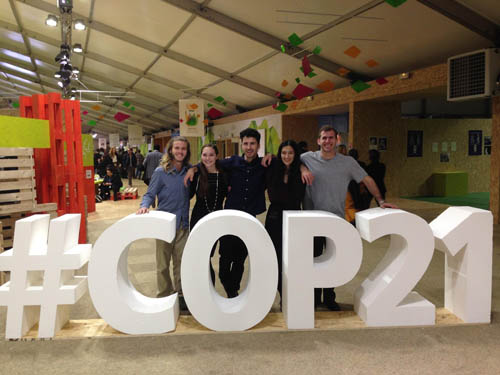
Harrison Beck ‘16, Isabella Soparkar ‘18, and Forest Redlin ‘17
Wednesday, December 2, 2015
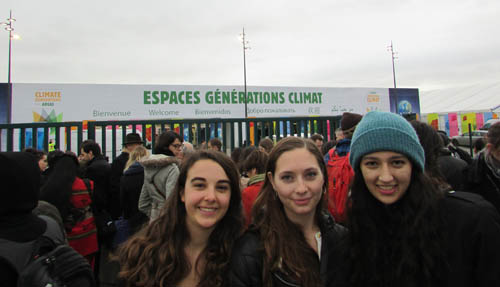
Tuesday, December 1, 2015
Day 2: Tuesday, December 1 by Chris Pieper and Akilah Sanders-Reed
Today marked the second day of COP, but the first day where the main nitty-gritty negotiating work began. The halls of the convention center were notably more subdued and the atmosphere more focused as delegates began their work on the negotiating text, a marked departure away from the busy, electric, and optimistic atmosphere which characterized COP’s opening yesterday. It’s clear that the grandiose opening ceremony and statements by political leaders has concluded, and that delegates have now rolled up their sleeves and gotten to work.
The morning featured the opening plenary sessions of the Conference of the Parties (COP) and the Parties to the Kyoto Protocol (CMP), which reviews and oversees the implementation of the Kyoto Protocol. Various working groups began working today, including the Subsidiary Body for Scientific and Technological Advice (SBSTA) which provides scientific and technical advice to the COP and CMP, and the Ad Hoc Working Group on the Durban Platform for Enhanced Action (ADP) which is responsible for developing a climate action protocol for parties to adopt that goes into effect in 2020. The meetings so far seem to be running smoothly and the representatives seem dedicated to efficiently working their way through various meeting agendas and negotiating texts.
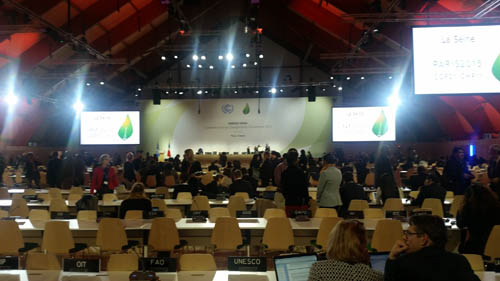
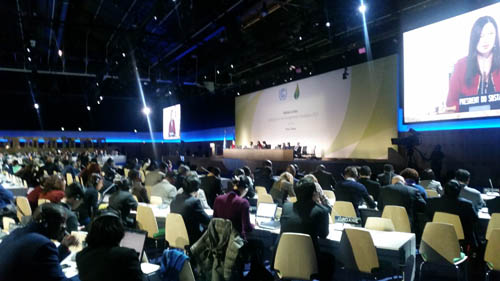
Today also marked the opening day of the Climate Generations Center, an exposition open to the public adjacent to the convention center featuring exhibits and side-events on a wide range of topics relating to COP-21. The trains and shuttles were packed as the influx of people eager to attend the expo descended upon the small suburb of Le Bourget. After an exciting conversation with a British journalist from Climate Home in line for the shuttle and a long wait at security, we finally entered the civil society arena of COP21.
The center of the Climate Generations pavilion housed overworked food vendors and brightly colored tables set up like an indoor cafe; adjoining rooms were filled with little booths sponsored by various NGOs. However, as we all explored what was at the Climate Generations pavilion, we also began to notice what wasn’t there: a sense of urgency, energy, and collaboration. The brightly painted plywood lent a forced light-heartedness to the space that obscured any connection to the significance of the proceedings in the official UN conference. The booths mimicked a corporate layout, advertising the logos of various well-meaning organizations. On a small hallway to the side, nine conference rooms housed a series of talks and panels which comprise the heart of the civil society conference. It’s easy to miss them, though – the schedule is only available online, and no signs or announcements remind conference-goers of the programming. We all came prepared to find a space that was somewhat artificial, but not so bland. Despite this, many of us are intrigued to find the human element – what brought everyone else to this strange space, and are they feeling similarly?
Nonetheless, we packed our day with gathering as much information as possible. Between Climate Generations and the events in the Convention Center, dozens of side-events and exhibits are being showcased throughout the day. Jessica attended events at the Rio Pavilion on agriculture and forestry, where she heard from delegates from Senegal, South Africa, Paraguay, France, Denmark, Morocco, and the Dominican Republic about the effects their countries already experience from climate change. Kayla and Isabella listened to a brief presentation by indigenous peoples of the Amazon on invasive corporate presence in their homelands. Chris sat in on the SBSTA plenary session in the morning and attended a side-event about the role of cities and subnational actors in promoting climate action and mitigation, particularly in South Asia. Panelists gave examples of local action through case studies in India, Bangladesh, Pakistan, and Sri Lanka.
In the evening, we took the metro to Sciences Po, where we met up with our friends from St. John’s/St. Ben’s University. There, we engaged in a climate policy seminar with Professors Jon Marco Church and Kari Pryck on French climate policy, a history of climate action in Europe, and background on COP-21 being held in Paris. Although we were tired after such a long day at COP-21, we found the seminar to be engaging and informative, and it allowed us to learn more about these important topics that we didn’t know very much about in order to contextualize our experience here.
We concluded the evening by exploring the many shops, cafes, and boulevards in Paris’s famous Latin Quarter.
Tuesday, December 1, 2015
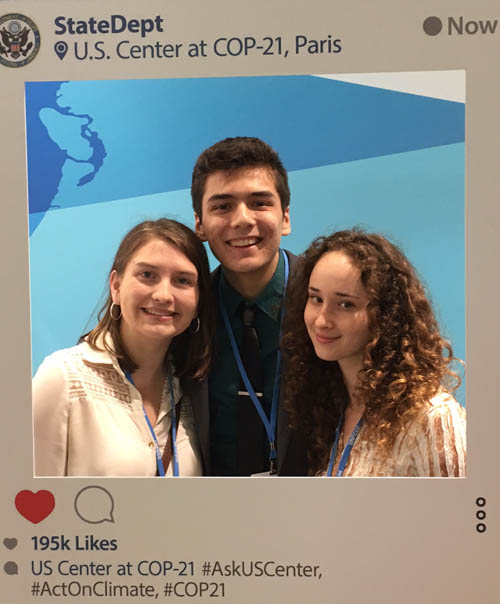
Monday, November 30, 2015
Day 1: Monday, November 30 by Mariah Carray and Kayla Walsh
On Monday, a group of us with badges for the “Blue Zone” participated in the opening ceremonies for the official COP21 Conference! The conference was a whirlwind of energy. Delegates from all over the world, dressed in everything from feathers to Armani, proudly represented their countries. Experienced COP attendees and official party delegates carried out their negotiating routines.
One hundred and fifty Presidents, Excellencies and Prime Ministers attended the event, and took turns addressing the plenary in short speeches. The world leaders walked with intention, flanked by their bodyguards and advisors. We were interrupted by stampedes of media running to get ahead to take the “family photo” of the world leaders. The themes of “family”, “solidarity” and “unity” are key to achieving success at Paris and were echoed in the leader’s speeches.
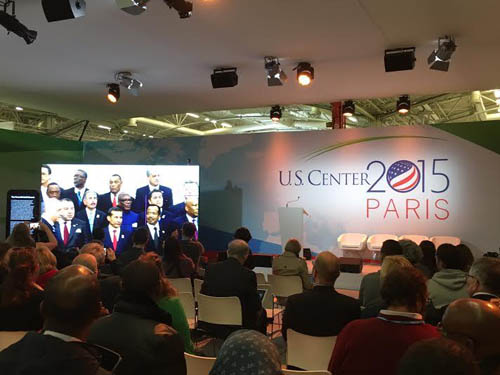
While words may ring with hope, a history of division and blame shifting underlies these promises. One French woman I spoke with rolled her eyes when I mentioned optimism. Mr. Tom Goldtooth, leader of the Indigenous Environmental Network, spoke of the injustice of capitalism and climate change. India spent over a million dollars on a pavilion with a light-up water show, demonstrating their prowess and commitment to just renewable energies. Yet, they are reluctant to come sit at the bargaining table.
Another underlying theme of these speeches is the recent terrorist attacks. World leaders use this to draw new found solidarity and emphasize peace. It will be interesting to see how these two global issues parallel one another as climate talks continue.
However, not everyone was cynical. Some people in the audience were full of optimism. Several strangers turned introductory handshakes into hugs in their excitement. The idea being—this time we will get it right, this time the world will come together.
Meanwhile…
Students without conference badges started their day early at the climate action hub called PlacetoB, which is a restaurant in the heart of Paris specifically designed to be a headquarters for international and civil media society to research or discuss COP21. After networking, the Mac crew serendipitously met friends from Edina, MN! Paul and Mindi from Citizen’s Climate Lobby and Cool Planet graciously agreed to interview us for a podcast tomorrow morning. We are constantly amazed by people’s willingness to connect with us — as representatives of the youth climate movement — to collaborate, share, and inspire.
Eventually, we found ourselves at the hub of Climate Action Network to join them in watching the opening livestream of the conference. Political theater ensued with Obama acknowledging not only the imperativeness of climate change, but also developed nations’ responsibility to assist the developing! In contrast, many small island nations grounded their talks in moral imperatives. Hardly any leader’s speech began without tribute to the recent Paris attacks. Angela Merkel said, “Through our presence here today we show we are stronger than the terrorists.” Recent events force us and our world leaders to acknowledge the close ties between climate insecurity and terrorism.
Climate Generations, a civil society space for side events at the conference venue was closed today. This lull in the action only motivated us to hit the halls tomorrow, interviewing climate leaders, attending relevant talks, and furthering our research.
In our surprisingly open afternoon, we were able to marvel at the wonders of Paris… like the Louvre and Notre Dame! Here’s to a successful negotiations session on Tuesday.
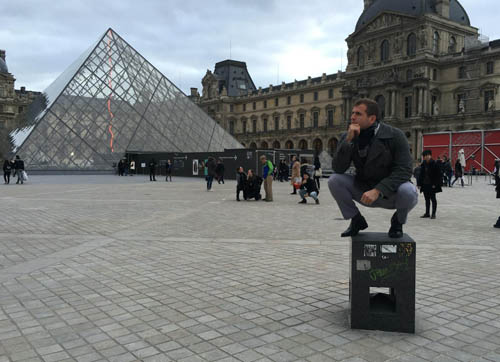
Sunday, November 29, 2015
Paris by Prof. Roopali Phadke
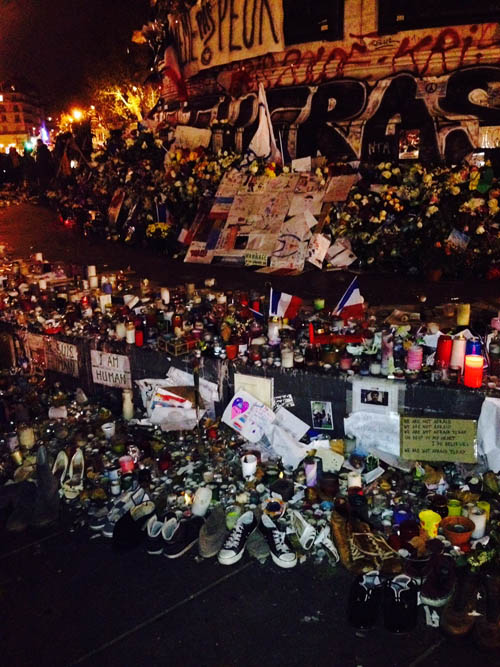
As we walked Paris last night, on the eve of the UN climate summit, we were reminded about how extraordinary a moment this is. Despite a ban on demonstrations, climate protestors gathered at the Place de la Republique in defiance yesterday afternoon. Activists showed their symbolic presence by laying down hundreds of shoes in the square, including Pope Francis’s formal black shoes and running sneakers from UN chief Ban Ki-moon.
Later that evening, a solemn spirit occupied the square. Around the base of the bronze 30 foot sculpture of Marianne, a makeshift shrine reveres those slain on November 13 nearby at the Bataclan theater. It reminds us of the city’s still open wounds. Last night the candles burned alongside the left shoes and messages for climate action. This is the kind of resilient creativity the world associates with Paris.
Unbeknownst to us, just down the block last night, President Obama, French President Hollande and Paris’ Mayor Anna Hidalgo were also paying tribute at the site of the Bataclan.
Our first day in Paris was eerily quiet as the city is still in a state of emergency. It made climbing the Eiffel Tower for our students a rather quiet affair compared to the usual throngs of tourists.
Today we make our way to the COP21 site for the opening of this historic meeting – an expected gathering of 150 Heads of State, the largest ever. A record 40,000 observers will also be present.
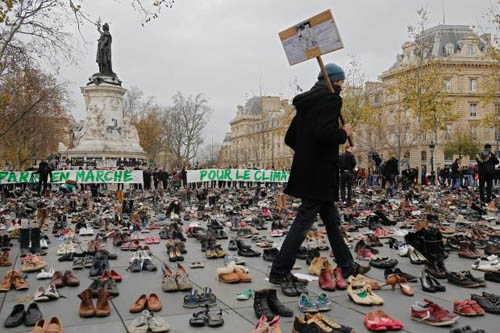
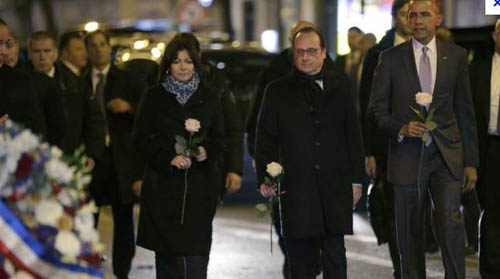
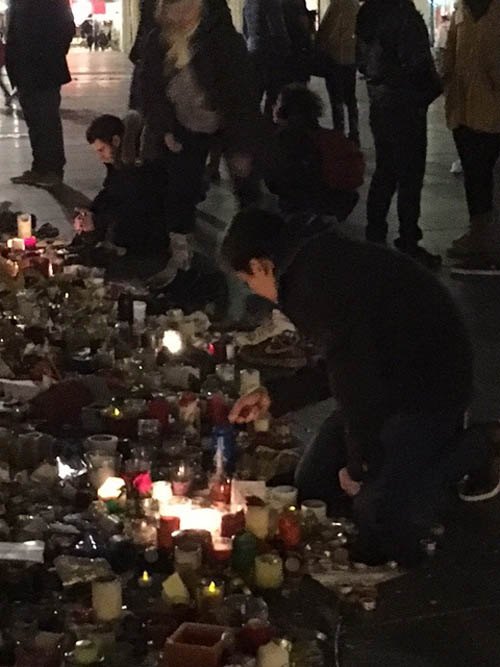
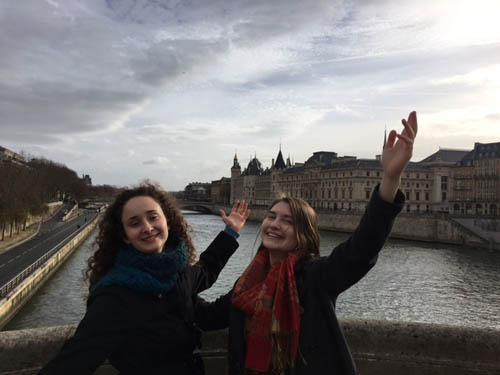
Saturday, November 28, 2015
